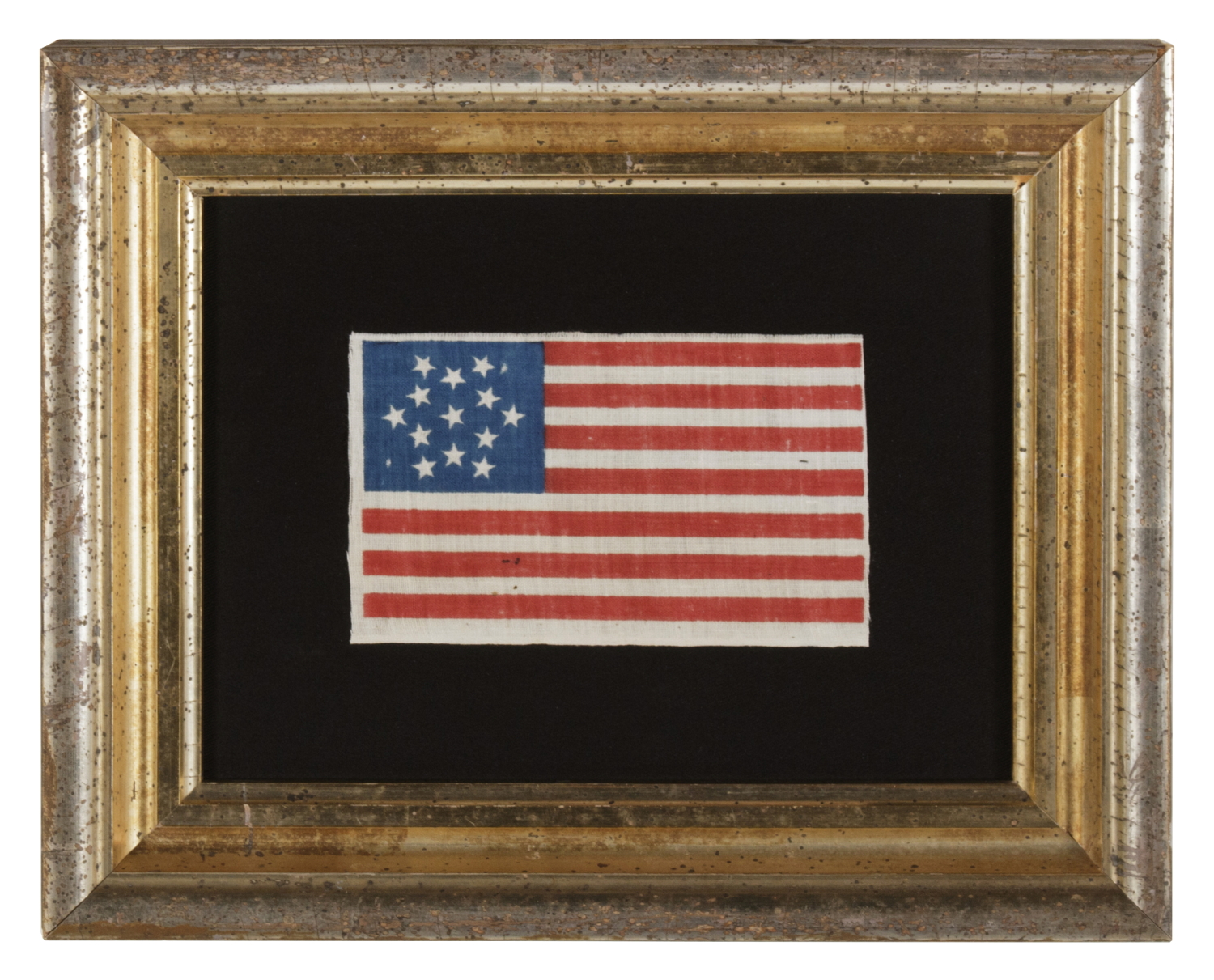
| |
13 STARS IN A SIX-POINTED GREAT STAR / STAR OF DAVID PATTERN, ON AN ANTIQUE AMERICAN FLAG MADE FOR THE 1876 CENTENNIAL OF AMERICAN INDEPENDENCE, FORMERLY IN THE MASTAI COLLECTION |
|
| Available: |
Sold |
| Frame Size (H x L): |
8.75" x 10.75" |
| Flag Size (H x L): |
3" x 5" |
|
| Description....: |
|
13 star American national parade flag, printed on plain weave cotton. The stars are arranged in a six-pointed version of what is known as the "Great Star" or "Great Luminary" pattern, distinguished by one large star made out of smaller ones.
Though the reason behind the decision to select this particular design is not known, several explanations are plausible. One is that it mimics the arrangement of stars found on the Great Seal of the United States, which appears within the cloud-like formation above the American eagle. This can be most ready viewed on the flag of the President of the United States or the back of the U.S. one-dollar bill.
In present times, one might identify the design as the Star of David, though this symbol, also known as the Shield of David, was not in widespread use by members of the Jewish faith until the 20th century. It could be that the star configuration draws a connection between this particular flag and a historical example of the Revolutionary War era. No 18th century flags are presently known to have survived with this pattern, however, and I know of none that are illustrated in period paintings or drawings. It may be that the source was simply lost to time, but whatever the case may be, one may note that it does represent the most logical manner by which 13 stars may be arranged in a star-shaped pattern.
Most surviving parade flags of the 19th century with 13 stars were produced for the 1876 celebration of our nation’s independence. This particular variety is known to have been printed alongside a rare variety of 39 star parade flag, with a circular star configuration, that was being produced in the same year. Although 37 remained the official star count until July 4th, 1777, many flag makers added a 38th star following the addition of Colorado as the 38th state on August 1st, 1876. Many flag-makers were actually producing 39 star flags, however, in hopeful anticipation of the addition of another Western Territory, though the event would not occur until 13 years later, in 1889. Because flag-making was a competitive venture, all sorts of interesting things were occurring as new states entered the union and makers vied against one-another for market share, always happy for a reason to update the flag and create demand.
One should note that what appears to be a 14th stripe is instead just the space between this and the next flag on the bolt of cotton fabric, on which the flag was printed.
This flag was formerly part of the Mastai Collection. I first acquired it in 2002 or 2003 from the Mastai estate. The Mastai’s held one of the most important private collections of American flags in the country, and their landmark book “The Stars & The Stripes: The American Flag as Art and as History from the Birth of the Republic to the Present” (1973, Alfred A. Knopf, Inc., New York) was the first major pictorial reference on flag collecting.
13 star flags have been flown throughout our nation’s history for a variety of purposes. In addition to their use at the centennial, they were hoisted at all manner of patriotic events, including Lafayette’s visit in 1824-25, celebrations of Independence Day, and the sesquicentennial in 1926. They were displayed during the Civil War, to reference past struggles for American liberty and victory over oppression, and were used by 19th century politicians in political campaigning for the same reason. The U.S. Navy used the 13 star count on small boats until 1916, because it was easier to discern fewer stars at a distance on a small flag. Commercial flag-makers mirrored this practice and some private ships flew 13 star flags during the same period as the Navy. The use of yachting ensigns with a wreath of 13 stars, surrounding a fouled anchor, which allowed pleasure boats to bypass customs between 1848 and 1980, persists today without an official purpose.
Provenance: Ex-Jim Ring Collection, Ex-Jeff R. Bridgman American Antiques, LLC, Ex-Mastai Collection.
Mounting: The flag was mounted and framed within our own conservation department, which is led by expert staff. We take great care in the mounting and preservation of flags and have framed thousands of examples.
The mount was then placed in a paint-decorated and gilded molding that dates to the period between 1820 and 1860. The flag has been placed in its correct vertical position, with its canton in the upper left. The background is 100% cotton twill, black in color, that has been washed and treated to reduce and set the dye. Spacers keep the textile away from the glass, which is U.V. protective.
Condition: There are two tiny spots of misprinting in the canton. There is a tiny hole in the 3rd white stripe, near the fly end, and a pinprick-sized hole in the 6th white stripe, below the canton, accompanied by minor dots of staining in the same area. Many of my clients prefer early flags to show their age and history of use. |
|
|
|
| Collector Level: |
Advanced Collectors and the Person with Everything |
|
| Flag Type: |
Parade flag |
|
| Star Count: |
13 |
|
| Earliest Date of Origin: |
1876 |
|
| Latest Date of Origin: |
1876 |
|
| State/Affiliation: |
13 Original Colonies |
|
| War Association: |
|
|
| Price: |
SOLD |
|
| |
Views: 257 |
|
|
|

